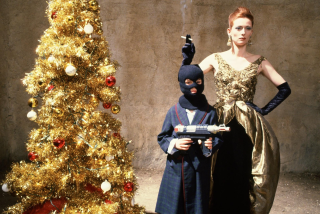Experimental filmmaking that countered Hollywood
From the late 1940s through the present day, a certain well-known California city has been the epicenter of intrepid, innovative filmmaking that has dazzled viewers and shredded the conventions of traditional narrative cinema.
Hint: It isn’t Los Angeles.
To be sure, L.A. has nurtured its own highly impactful experimental film scene and spawned avant-garde giants and enfants terribles like Kenneth Anger and Pat O’Neill. But the metropolis in question is greater San Francisco.
For decades, the Bay Area has supported one of the world’s most prolific, stylistically free-form and influential alternative-film environments. Long overshadowed by the Hollywood industry, the Bay region’s experimental-underground film and video culture has continued to thrive into the early 21st century, surviving natural disasters, demographic upheaval and even the Silicon Valley-generated cash influx that sent rents skyrocketing and drove many San Francisco artists into exile, or at least to the more affordable East Bay.
This month, that dynamic milieu is getting its due with “Radical Light: Alternative Film and Video in the San Francisco Bay Area, 1945-2000,” a series of screenings being sponsored by REDCAT (at its multipurpose space inside Walt Disney Concert Hall), the UCLA Film & Television Archive (at the Hammer Museum’s Billy Wilder Theater), Los Angeles Contemporary Exhibitions (LACE) on Hollywood Boulevard, and L.A. Filmforum (at the Spielberg Theatre at the Egyptian and the Echo Park Film Center).
Cut into rough thematic blocks such as “Landscape as Expression” and “Beat Era San Francisco,” “Radical Light” pays tribute directly to the legions of filmmakers and indirectly to the exhibitors, distributors, film societies, local colleges and, perhaps most importantly, the risk-taking audiences who supported them in creating and sustaining a community.
“There really was a feeling that if you wanted to do something, just get some friends together and do it,” said Steve Anker, REDCAT film co-curator, dean of the School of Film/Video at California Institute of the Arts, who lived in San Francisco for several years beginning in 1980.
The screenings tie in with the recently published book “Radical Light: Alternative Film and Video in the San Francisco Bay Area, 1945-2000,” co-edited by Anker and two curators from the Berkeley Art Museum/Pacific Film Archive, Kathy Geritz and Steve Seid.
Styling itself as “a kaleidoscopic compendium of writings and hundreds of period visuals chronicling the ongoing vitality of the Bay Area,” the profusely illustrated 350-page volume sketches the work and careers of such key Bay Area film and video artists as Stan Brakhage, the godfather of American avant-garde filmmaking, as well as Gunvor Nelson, Dorothy Wiley, James Broughton, Christopher Maclaine, Bruce Conner, Lawrence Jordan, Jay Rosenblatt and Alice Anne Parker Severson.
Relying on scattered grants, the Hotel Tax Fund and a do-it-yourselfer ethos that made a virtue of necessity, these artists drew energy from a famously tolerant and free-thinking city where anything that could be imagined might be permitted. By obsessively pursuing their own aesthetic and political objectives, Bay Area filmmakers collectively created an edgy cinematic parallel universe to counter commercial Hollywood.
“A lot of the alternative filmmaking was the alternative to Hollywood,” said Dominic Angerame, who has helped shape Bay Area visual culture both as a filmmaker (“Premonition”) and as executive director of Canyon Cinema, a home-grown exhibition-distribution company that has played a crucial role in exposing San Francisco artists’ work.
By contrast, Angerame said, many filmmakers who joined an exodus from Los Angeles to the Bay Area over the past century “either got tired” of laboring in Hollywood’s backyard or else found ways to cannibalize mainstream cinema and incorporate it into their own work.
The films being screened in Los Angeles suggest the vast range of Bay Area expression. They include “A Trip Down Market Street, 1905,” a 12-minute real-time vision of the city’s most iconic thoroughfare; Lawrence Jordan’s sepia-toned “Visions of a City” (1957), in which the roving poet-protagonist Michael McClure’s cubistically reflected image in car windows, mirrors and storefront displays creates a Baudelairean tone poem of the Beat era flâneur; Christopher Maclaine’s “The End,” a 35-minute stream-of-consciousness lament at the Cold War prospect of planetary suicide; and Nelson and Wiley’s “Schmeerguntz” (1966), a savagely humorous, proto-feminist deconstruction of postwar American consumerism’s squeaky-clean surfaces, and the crud that lurked beneath them.
Cauleen Smith, a filmmaker and professor of visual arts at UC San Diego, said that when she was studying cinema at San Francisco University in the early 1990s, the Bay Area’s relative affordability, artistic vitality and centrality in the gay rights, feminist and other social movements made it a kind of urban laboratory for young aspiring alternative cineastes.
“In one semester I had Angela Davis, Trinh T. Minh-ha and Lynn Hershman,” Smith said, referring to the African American political activist and two prominent Bay Area filmmakers cited in “Radical Light.”
“I was and still am amazed by the actual integrity of the [Bay Area] artists,” continued Smith, whose film “Chronicles of a Lying Spirit (by Kelly Gabron),” a 13-minute autobiographical meditation on the mediation of black history by white-male-dominated media, is being screened Sunday. “The way that they made art was exactly the way they saw the world, or the way they wanted it to be.”
More to Read
The biggest entertainment stories
Get our big stories about Hollywood, film, television, music, arts, culture and more right in your inbox as soon as they publish.
You may occasionally receive promotional content from the Los Angeles Times.











